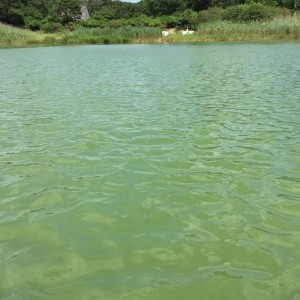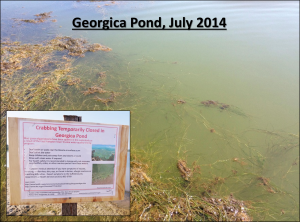As the mild winter has transitioned to a cool spring, and summer approaches, Georgica Pond is springing to life, good and bad. To recap, in 2015, the ocean inlet or cut remained open for the longest period in recent record, from January through late June, and the water quality remained good through most of that period although the macroalgae or seaweed or had begun to grow and expand across the Pond through June. Once the cut closed, it seemed to trigger a cascade of events that included the Pond being densely blanketed from bottom to surface with macroalgae for most of July followed by the decay of the macroalgae and the emergence of toxic blue-green algae in August and September. During the peak of these blooms, night-time oxygen levels that reach zero on several occasions and multiple species of fish were found to perish. The re-opening of the cut on October 8th 2015 ended the cycle, flushed the blue-green algae out of the Pond, and essentially ended the season of environmental threats to the Pond. The cut went through numerous iterations of open and closed thereafter, but last closed in late March of this year. The installation of the Stony Brook University water quality buoy has facilitated a clear picture of how Georgica Pond has responded. Following the closing of the Cut, salinity quickly dropped from 30 in early April to 15 by late April and presently being about 9 (see figure below, red line). At the same time, a dense microalgae bloom has developed in Georgica Pond (see figure, purple line). The causative species, Prorocentrum minimum, is also known as Mahogany Tide due to the dark brown color it yields in the water. Unlike the blue-green algae, this species is not a human or pet health risk, but its high densities can have some ecosystem impacts. Firstly, it is known to be harmful to oysters and scallops. Next, the very dense shading it causes is inhibitory to the growth of submerged aquatic vegetation (SAV). In some ecosystems, that is a large concern, as the dominant SAV is eelgrass, an important fish and shellfish habitat. In Georgica Pond, however, this might be a bit of good news, as the shading brought about by the Mahogany Tide seems to be inhibiting the growth of macroalgae. While unsightly macroalgae had already been proliferating through much of Georgica Pond last May and June, thus far in 2016, it has been at very low levels.
What will happen next in Georgica Pond is uncertain. The East Hampton Town Trustees had hoped to open the cut last month, but were unable to do so due to the nesting of Piping Plovers (an endangered species) on the ocean beach. Mahogany Tides are typically seasonal and as the Pond continues to warm, it is likely the Mahogany Tide will wane. Open questions include: 1. Whether / when blue-green algae might bloom in Georgica Pond? The salinity of the Pond is already permissive for such an occurrence but during the past two years they occurred only after blooms of macroalgae. 2. Whether / when macroalgae might bloom in Georgica Pond? If the Mahogany Tide clears up, the macroalgae may soon follow. 3. When will the cut next be open? Plovers typically nest through the summer, and the next opportunity may be next month.
Further updates on Georgica Pond will be provided through the season. Stay tuned.






